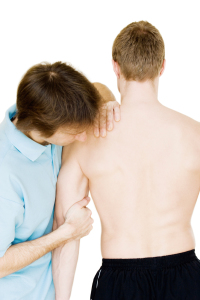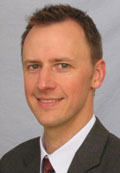Separated Shoulder Treatment
By Steven Meier
 A separated shoulder is technically known as an acromioclavicular joint separation or an AC joint separation. It is a very common shoulder injury and one that sometimes requires surgery to treat. Unfortunately, family doctors are not always equipped to properly evaluate and adequately treat these types of injuries. As a result, it is important to consult with a specialist like Dr. Meier in Los Angeles if you have sustained this type of shoulder injury.
A separated shoulder is technically known as an acromioclavicular joint separation or an AC joint separation. It is a very common shoulder injury and one that sometimes requires surgery to treat. Unfortunately, family doctors are not always equipped to properly evaluate and adequately treat these types of injuries. As a result, it is important to consult with a specialist like Dr. Meier in Los Angeles if you have sustained this type of shoulder injury.
If you have suffered an AC joint separation or AC joint sprain, call (310) 777-7845 to schedule an appointment for orthopedic services and sports medicine.
How Do Shoulder Separations Occur?
The shoulder joint is composed of three bones: the clavicle (collarbone), scapula (shoulder blade), and humerus (upper arm bone). The acromioclavicular (AC) joint is located at the distal end of the clavicle (the part of the collarbone furthest from the body’s center) and attaches to what is known as the acromion process of the shoulder blade.
The acromion of the shoulder blade connects to the clavicle via a ligament known as the acromioclavicular ligament, and the coracoclavicular ligaments (trapezoid and conoid ligaments) connect the collarbone to the coracoid process. Together, these three ligaments provide added support to the shoulder joint. Shoulder separations can adversely affect the ligaments, but usually, the bones are not fractured, save for severe and traumatic separations.
Shoulder separations typically occur due to the application of downward force onto the top of the acromion of the shoulder blade. This can be caused by something striking the top of the acromion or if you happen to fall directly on it. An AC joint injury is also more likely to occur if the shoulder is struck while the hand is outstretched.
The people most likely to suffer an acromioclavicular joint separation are those who participate in sports. The sports with the highest risk of suffering a separated shoulder include the following:
- Football
- Soccer
- Horseback riding
- Hockey
- Combat sports
- Rugby
- Snowboarding
- Bicycling
- Wrestling
Separation vs. Shoulder Dislocation
While the terms “separation” and “dislocation” might seem similar, a shoulder separation and a shoulder dislocation are actually two entirely different injuries. Furthermore, separations and dislocations occur in anatomically different places surrounding the shoulder joint.
A shoulder dislocation occurs when the humerus (upper arm bone) becomes dislodged from its normal place upon the scapula (shoulder blade) at the glenohumeral joint. On the other hand, separation occurs at the AC joint, which connects the clavicle to the scapula.
Degrees of Acromioclavicular Joint Separations
AC joint separations are classified into six types or grades. Grade I is the most minor and involves merely spraining of the ligaments without any tearing. Grades II and III involve tears of one or more of the ligaments stabilizing the acromioclavicular joint and some displacement of the clavicle. Grades IV through VI are the most severe, involving complete disruption of the AC joint, severe displacement of the clavicle, and usually, require surgical intervention.
Grade I AC joint separations can cause injury to the ligaments, but no complete tearing or fractures to any bones occurs. As a result, Grade I shoulder separations are referred to as AC joint sprains.
Grade II AC joint separations refer to injuries with complete tearing of the acromioclavicular ligament and partial tearing of the coracoclavicular ligaments. Type II shoulder separations cause a noticeable and potentially permanent bump deformity on the shoulder’s top. The clavicle is unstable, and severe pain and loss of movement of the arm can be expected.

Grade III acromioclavicular joint separations involve the tearing of both the acromioclavicular and coracoclavicular ligaments. A significant and potentially permanent bump is formed due to the clavicle’s dislocation, resulting in some shoulder deformity. The clavicle can also be reduced into place, and then when pressure is taken away, it will move back out of place. Pain with arm motion is also severe with Grade III shoulder separations.
Grade IV, Grade V, and Grade VI separations all include the characteristics of a Grade III injury but with more severe indications. Grade IV shoulder separations involve tearing of the coracoclavicular ligament connecting the collarbone, which results in a displaced collarbone. This type of injury usually requires surgery to effectively treat.
In Grade V separations, trapezius and deltoid muscle tissue, both of which surround the bony frame, or girdle, of the shoulder, also may become detached from the shoulder blade and the collarbone. This results in a much more significant shoulder separation and necessarily requires surgery to fix.
Grade VI acromioclavicular joint separations usually are caused by severe trauma and are usually accompanied by several other injuries. Surgery will be required to clear all the damaged tissue and then surgically reattach it in order to reconstruct the anatomical shoulder frame. This type of injury is extremely rare, resulting from tremendous force to the shoulder girdle, and generally only occurs in situations such as automobile accidents.
Diagnosis
Separated shoulders can be diagnosed through both a physical exam and X-ray imaging. AC joint separation can often be identified through several means during the clinical examination.
Non-Surgical Treatment
Acutely, the first treatment for minor AC joint injuries can be to apply ice, and refrain from activity with the injured shoulder. Anti-inflammatory medications such as ibuprofen (Advil or Motrin), or naproxen (Aleve), or regenerative medicine techniques can help to minimize both pain and inflammation. Further treatment depends upon the severity of the shoulder injury.
The most common types of shoulder separations (Grade I and Grade II) rarely require surgery. Most treatments involve physical therapy, which is designed to strengthen the muscles and aid in joint stabilization, as well as regenerative medicine treatments, such as platelet-rich plasma therapy, stem cell therapy, or prolotherapy.
Some Grade III AC joint separations can be treated successfully without surgery, but other patients may experience less pain in the long term after surgical repair. For those taking the non-surgical route, range-of-motion exercises can be started once pain subsides. A strength training program follows and will include the strengthening of rotator cuff and shoulder blade muscles. Most of the time, the pain tends to go away after a few weeks, but a full recovery might not occur for six weeks with Grade II separations and up to 12 weeks for Grade III injuries.
While most people with separated shoulders can return to full function, some may have lingering pain in the AC joint area. This pain can be caused by arthritis, another injury to the shoulder cartilage, or bone-on-bone contact when the joint is in motion. Surgical treatment for these conditions may help alleviate the continued pain.
Surgery for AC Joint Separations
The severe shoulder separations (Grade IV-VI) are rare but usually require arthroscopic shoulder procedures to treat. (Grade III injuries vary from case-to-case on whether or not surgery is necessary.) The only certainty is that people in Los Angeles who avoid surgery return to their regular activities quicker than those that choose the surgical route, but they might need surgery further down the road as the joint can degenerate and become arthritic and painful later on in life. medlineplus.gov explains how to care for your shoulder after surgery.
Contact an AC Joint Injury Specialist
Dr. Meier and his team in Los Angeles are experts in shoulder injury treatment. Everyone, from the doctors, to the nurses, to the support staff, work hard so that patients receive the high-quality medical care needed to achieve the maximum possible recovery.
If you have suffered an AC joint sprain or separation, contact the Beverly Hills orthopedic surgeons at Meier Orthopedic Sports and Regenerative Medicine today at (310) 777-7845, or fill out our contact form, and someone from our office will be in touch with you shortly.
We look forward to helping you regain your full health.
